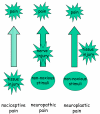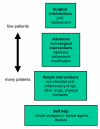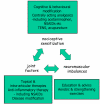Arthritis and pain. Current approaches in the treatment of arthritic pain
- PMID: 17572915
- PMCID: PMC2206347
- DOI: 10.1186/ar2147
Arthritis and pain. Current approaches in the treatment of arthritic pain
Abstract
Current evidence suggests that although persistent arthritic pain is initiated and maintained by articular pathology, it is also heavily influenced by a range of other factors. Strategies for treating arthritic pain are therefore different from those adopted for acute pain. Although published guidelines offer general assistance, the complexity of underlying mechanisms requires that measures designed to relieve pain must take into account individual biological, psychological and societal factors. It follows that a combination of both pharmacological and non-pharmacological approaches offers the best opportunity for therapeutic success, although determining the effectiveness of such complex interventions remains difficult. Pharmacological therapy is often prolonged, and safety and tolerability issues become as important as efficacy over time.
Figures





References
-
- Woolf CJ. Pain: moving from symptom control toward mechanism-specific pharmacologic management. Ann Intern Med. 2004;140:441–451. - PubMed
-
- Kidd BL. The mechanisms of chronic pain. In: Breivik H, Shipley M, editor. Pain: Best Practice and Research Compendium. Edinburgh: Elsevier; 2006. pp. 17–24.
Publication types
MeSH terms
LinkOut - more resources
Full Text Sources
Medical

